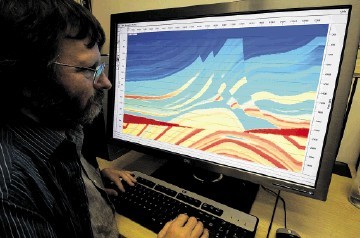
Researchers at Imperial College London have embarked on an ambitious three-year project that aims to deliver a step change in seismic imaging and understanding of hydrocarbon reservoir targets.
The team of researchers, led by Professor Mike Warner, have secured more than £1million in funding for the “Fullwave Gamechanger” work from eight companies through the Aberdeen-based Industry Technology Facilitator (ITF).
The focus of the project is the technique of full-wavefield tomography, also known as full-wavefield inversion, which is a method for seismic depth imaging and obtaining models of physical properties in the sub-surface at high spatial resolution.
Seismic is the most widely applied survey technique used for oil and gas exploration and seismic tomography uses information about the velocity at which seismic waves travel, to derive information about geological structures.
The various seismic techniques used by the upstream industry generate vast quantities of data, the analysis of which involves a complex computing process called inversion, to generate models of the earth’s layered geological structure.
Research into the use of advanced imaging technologies and processing of the data collected is key to improving the industry’s ability to accurately identify and “map” the presence of hydrocarbons.
Prof Warner said: “In contrast to conventional seismic tomography, where we minimise the mismatch between observed and calculated seismic travel times, in full-wavefield tomography we are seeking to create a highly resolved quantitative model of the subsurface structure that is able to explain all aspects of the recorded seismic wavefield.
“We are aiming to match to the raw field data, in detail, wiggle-for-wiggle.
“Wavefield tomography has a long history, but it is only recently that advances in mathematical algorithms, as well as in hardware, have made the technique feasible on realistic-sized datasets in three dimensions.
“These advances have enabled wavefield tomography to develop from a technique of largely academic interest into a commercially relevant tool that is igniting interest across the industry worldwide.”
This new project continues on from previous phases of ITF member-funded work undertaken by Prof Warner’s research group over the past six years.
The most recently completed phase, Fullwave III, developed techniques leading to improved understanding of the “top layers” geologically speaking, that is, the overburden as well as what lies beneath it.
ITF say a number of the sponsors have run the 3D full-waveform inversion code in-house on their own datasets with positive outcomes.
In addition, a geophysical service provider has been actively involved in the project and can now offer full-waveform inversion as a commercial service to clients.
Senior technology analyst at ITF, Colin Sanderson said of the decision to push ahead with further wavefield inversion research: “Discussions with our members tell us that industry is looking for different ideas to improve the imaging of and below problem layers, and this is something that Fullwave Gamechanger aims to address.
“The defined problem layers correspond to those of high impedance such as salt, basalt and chalk and low impedance such as gas and glacial channels.
“Trying to “look” through these layers to the reservoir is effectively like trying to look through a cloudy piece of glass.
“Full wavefield tomography promises to deliver a step-change in seismic resolution, fidelity and industrial practice, but at the current stage in its development it is not yet fully effective at reservoir depth, and also has some limitations with respect to handling reflections.
“This project will build on previous work to tackle these issues and develop the next generation of integrated wavefield-tomographic tools.”
For more information on this project, please contact: c.sanderson@itfenergy.com